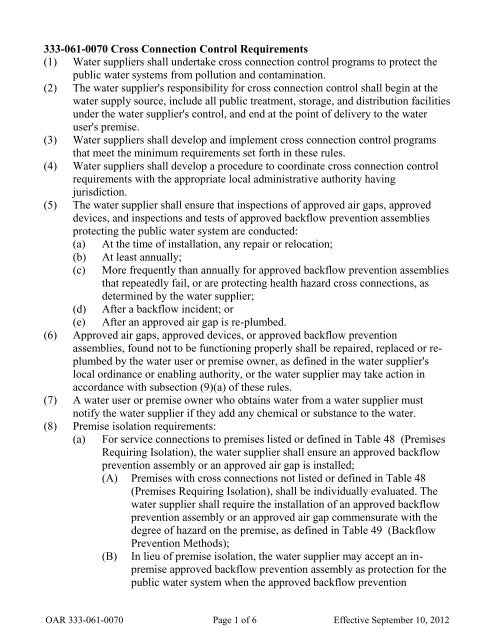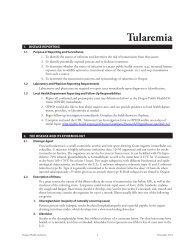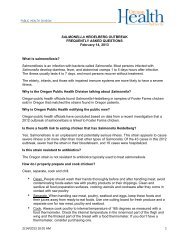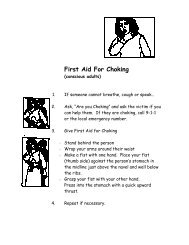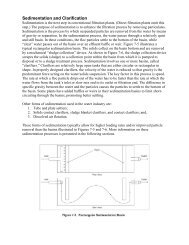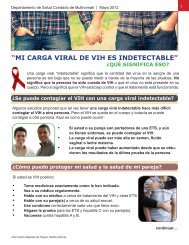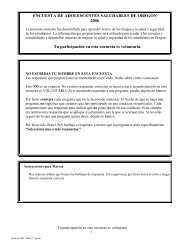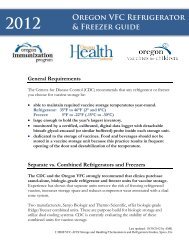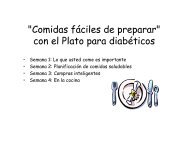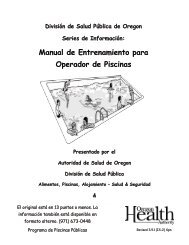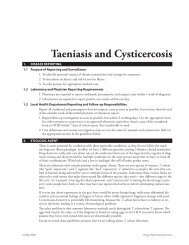333-061-0070 Cross Connection Control ... - Public Health
333-061-0070 Cross Connection Control ... - Public Health
333-061-0070 Cross Connection Control ... - Public Health
Create successful ePaper yourself
Turn your PDF publications into a flip-book with our unique Google optimized e-Paper software.
<strong>333</strong>-<strong>061</strong>-<strong>0070</strong> <strong>Cross</strong> <strong>Connection</strong> <strong>Control</strong> Requirements<br />
(1) Water suppliers shall undertake cross connection control programs to protect the<br />
public water systems from pollution and contamination.<br />
(2) The water supplier's responsibility for cross connection control shall begin at the<br />
water supply source, include all public treatment, storage, and distribution facilities<br />
under the water supplier's control, and end at the point of delivery to the water<br />
user's premise.<br />
(3) Water suppliers shall develop and implement cross connection control programs<br />
that meet the minimum requirements set forth in these rules.<br />
(4) Water suppliers shall develop a procedure to coordinate cross connection control<br />
requirements with the appropriate local administrative authority having<br />
jurisdiction.<br />
(5) The water supplier shall ensure that inspections of approved air gaps, approved<br />
devices, and inspections and tests of approved backflow prevention assemblies<br />
protecting the public water system are conducted:<br />
(a) At the time of installation, any repair or relocation;<br />
(b) At least annually;<br />
(c) More frequently than annually for approved backflow prevention assemblies<br />
that repeatedly fail, or are protecting health hazard cross connections, as<br />
determined by the water supplier;<br />
(d) After a backflow incident; or<br />
(e) After an approved air gap is re-plumbed.<br />
(6) Approved air gaps, approved devices, or approved backflow prevention<br />
assemblies, found not to be functioning properly shall be repaired, replaced or replumbed<br />
by the water user or premise owner, as defined in the water supplier's<br />
local ordinance or enabling authority, or the water supplier may take action in<br />
accordance with subsection (9)(a) of these rules.<br />
(7) A water user or premise owner who obtains water from a water supplier must<br />
notify the water supplier if they add any chemical or substance to the water.<br />
(8) Premise isolation requirements:<br />
(a) For service connections to premises listed or defined in Table 48 (Premises<br />
Requiring Isolation), the water supplier shall ensure an approved backflow<br />
prevention assembly or an approved air gap is installed;<br />
(A) Premises with cross connections not listed or defined in Table 48<br />
(Premises Requiring Isolation), shall be individually evaluated. The<br />
water supplier shall require the installation of an approved backflow<br />
prevention assembly or an approved air gap commensurate with the<br />
degree of hazard on the premise, as defined in Table 49 (Backflow<br />
Prevention Methods);<br />
(B) In lieu of premise isolation, the water supplier may accept an inpremise<br />
approved backflow prevention assembly as protection for the<br />
public water system when the approved backflow prevention<br />
OAR <strong>333</strong>-<strong>061</strong>-<strong>0070</strong> Page 1 of 6 Effective September 10, 2012
assembly is installed, maintained and tested in accordance with the<br />
Oregon Plumbing Specialty Code and these rules.<br />
(b) Where premise isolation is used to protect against a cross connection, the<br />
following requirements apply;<br />
(A) The water supplier shall:<br />
(i) Ensure the approved backflow prevention assembly is installed<br />
at a location adjacent to the service connection or point of<br />
delivery;<br />
(ii) Ensure any alternate location used must be with the approval of<br />
the water supplier and must meet the water supplier's cross<br />
connection control requirements; and<br />
(iii) Notify the premise owner and water user, in writing, of thermal<br />
expansion concerns.<br />
(B) The premise owner shall:<br />
(i) Ensure no cross connections exist between the point of delivery<br />
from the public water system and the approved backflow<br />
prevention assemblies, when these are installed in an alternate<br />
location; and<br />
(ii) Assume responsibility for testing, maintenance, and repair of<br />
the installed approved backflow prevention assembly to protect<br />
against the hazard.<br />
(c) Where unique conditions exist, but not limited to, extreme terrain or pipe<br />
elevation changes, or structures greater than three stories in height, even<br />
with no actual or potential health hazard, an approved backflow prevention<br />
assembly may be installed at the point of delivery; and<br />
(d) Where the water supplier chooses to use premise isolation by the installation<br />
of an approved backflow prevention assembly on a one- or two-family<br />
dwelling under the jurisdiction of the Oregon Plumbing Specialty Code and<br />
there is no actual or potential cross connection, the water supplier shall:<br />
(A) Install the approved backflow prevention assembly at the point of<br />
delivery;<br />
(B) Notify the premise owner and water user in writing of thermal<br />
expansion concerns; and<br />
(C) Take responsibility for testing, maintenance and repair of the installed<br />
approved backflow prevention assembly.<br />
(9) In community water systems, water suppliers shall implement a cross connection<br />
control program directly, or by written agreement with another agency experienced<br />
in cross connection control. The local cross connection program shall consist of the<br />
following elements:<br />
(a) Local ordinance or enabling authority that authorizes discontinuing water<br />
service to premises for:<br />
(A) Failure to remove or eliminate an existing unprotected or potential<br />
cross connection;<br />
OAR <strong>333</strong>-<strong>061</strong>-<strong>0070</strong> Page 2 of 6 Effective September 10, 2012
(B) Failure to install a required approved backflow prevention assembly;<br />
(C) Failure to maintain an approved backflow prevention assembly; or<br />
(D) Failure to conduct the required testing of an approved backflow<br />
prevention assembly.<br />
(b) A written program plan for community water systems with 300 or more<br />
service connections shall include the following:<br />
(A) A list of premises where health hazard cross connections exist,<br />
including, but not limited to, those listed in Table 48 (Premises<br />
Requiring Isolation);<br />
(B) A current list of certified cross connection control staff members;<br />
(C) Procedures for evaluating the degree of hazard posed by a water user's<br />
premise;<br />
(D) A procedure for notifying the water user if a non-health hazard or<br />
health hazard is identified, and for informing the water user of any<br />
corrective action required;<br />
(E) The type of protection required to prevent backflow into the public<br />
water supply, commensurate with the degree of hazard that exists on<br />
the water user's premise, as defined in Table 49 (Backflow Prevention<br />
Methods);<br />
(F) A description of what corrective actions will be taken if a water user<br />
fails to comply with the water supplier's cross connection control<br />
requirements;<br />
(G) Current records of approved backflow prevention assemblies installed,<br />
inspections completed, backflow prevention assembly test results on<br />
backflow prevention assemblies and verification of current Backflow<br />
Assembly Tester certification; and<br />
(H) A public education program about cross connection control.<br />
(c) The water supplier shall prepare and submit a cross connection control<br />
Annual Summary Report to the Authority, on forms provided by the<br />
Authority, before the last working day of March each year.<br />
(d) In community water systems having 300 or more service connections, water<br />
suppliers shall ensure at least one person is certified as a <strong>Cross</strong> <strong>Connection</strong><br />
<strong>Control</strong> Specialist, unless specifically exempted from this requirement by<br />
the Authority.<br />
(10) Fees: Community water systems shall submit to the Authority an annual cross<br />
connection program implementation fee, based on the number of service<br />
connections, as follows:<br />
Service <strong>Connection</strong>s: Fee:<br />
15-99 $30.<br />
100-999 $75.<br />
1,000-9,999 $200.<br />
10,000 or more $350.<br />
OAR <strong>333</strong>-<strong>061</strong>-<strong>0070</strong> Page 3 of 6 Effective September 10, 2012
(a) Billing invoices will be mailed to water systems in the first week of<br />
November each year and are due by January first of the following year;<br />
(b) Fees are payable to Oregon <strong>Health</strong> Authority by check or money order;<br />
(c) A late fee of 50 percent of the original amount will be added to the total<br />
amount due and will be assessed after January 31 of each year.<br />
(11) In transient or non-transient non-community water systems, the water supplier that<br />
owns and/or operates the system shall:<br />
(a) Ensure no cross connections exist, or are isolated from the potable water<br />
system with an approved backflow prevention assembly, as required in<br />
section (12) of this rule;<br />
(b) Ensure approved backflow prevention assemblies are installed at, or near,<br />
the cross connection; and<br />
(c) Conduct a cross connection survey and inspection to ensure compliance with<br />
these rules. All building permits and related inspections are to be made by<br />
the Authority of Consumer and Business Services, Building Codes Division,<br />
as required by ORS 447.020.<br />
(12) Approved backflow prevention assemblies required under these rules shall be<br />
assemblies approved by the University of Southern California, Foundation for<br />
<strong>Cross</strong> <strong>Connection</strong> <strong>Control</strong> and Hydraulic Research, or other equivalent testing<br />
laboratories approved by the Authority.<br />
(13) Backflow prevention assemblies installed before the effective date of these rules<br />
that were approved at the time of installation, but are not currently approved, shall<br />
be permitted to remain in service provided the assemblies are not moved, the<br />
piping systems are not significantly remodeled or modified, the assemblies are<br />
properly maintained, and they are commensurate with the degree of hazard they<br />
were installed to protect. The assemblies must be tested at least annually and<br />
perform satisfactorily to the testing procedures set forth in these rules.<br />
(14) Tests performed by Authority-certified Backflow Assembly Testers shall be in<br />
conformance with procedures established by the University of Southern California,<br />
Foundation for <strong>Cross</strong> <strong>Connection</strong> <strong>Control</strong> and Hydraulic Research, Manual of<br />
<strong>Cross</strong> <strong>Connection</strong> <strong>Control</strong>, 9th Edition, December 1993, or other equivalent testing<br />
procedures approved by the Authority.<br />
(15) Backflow prevention assemblies shall be tested by Authority-certified Backflow<br />
Assembly Testers, except as otherwise provided for journeyman plumbers or<br />
apprentice plumbers in OAR <strong>333</strong>-<strong>061</strong>-0072 of these rules (Backflow Assembly<br />
Tester Certification). The Backflow Assembly Tester shall provide a copy of each<br />
completed test report to the water user or premise owner, and the water supplier:<br />
(a) Within 10 working days; and<br />
(b) The test reports will be in a manner and form acceptable to the water<br />
supplier.<br />
(16) All approved backflow prevention assemblies subject to these rules shall be<br />
installed in accordance with OAR <strong>333</strong>-<strong>061</strong>-0071 and the Oregon Plumbing<br />
Specialty Code.<br />
OAR <strong>333</strong>-<strong>061</strong>-<strong>0070</strong> Page 4 of 6 Effective September 10, 2012
(17) The Authority shall establish an advisory board for cross connection control issues<br />
consisting of not more than nine members, and including representation from the<br />
following:<br />
(a) Oregon-licensed Plumbers;<br />
(b) Authority-certified Backflow Assembly Testers;<br />
(c) Authority-certified <strong>Cross</strong> <strong>Connection</strong> Specialists;<br />
(d) Water Suppliers;<br />
(e) The general public;<br />
(f) Authority-certified Instructors of Backflow Assembly Testers or <strong>Cross</strong><br />
<strong>Connection</strong> Specialists;<br />
(g) Backflow assembly manufacturers or authorized representatives;<br />
(h) Engineers experienced in water systems, cross connection control and/or<br />
backflow prevention; and<br />
(i) Oregon-certified Plumbing Inspectors.<br />
TABLE 48<br />
PREMISES REQUIRING ISOLATION* BY<br />
AN APPROVED AIR GAP<br />
OR<br />
REDUCED PRESSURE PRINCIPLE TYPE OF ASSEMBLY<br />
HEALTH HAZARD<br />
1. Agricultural (e.g. farms, dairies)<br />
2. Beverage bottling plants**<br />
3. Car washes<br />
4. Chemical plants<br />
5. Commercial laundries and dry cleaners<br />
6. Premises where both reclaimed and potable water are used<br />
7. Film processing plants<br />
8. Food processing plants<br />
9. Medical centers (e.g., hospitals, medical clinics, nursing homes, veterinary<br />
clinics, dental clinics, blood plasma centers)<br />
10. Premises with irrigation systems that use the water supplier’s water with<br />
chemical additions (e.g., parks, playgrounds, golf courses, cemeteries, housing<br />
estates)<br />
11. Laboratories<br />
12. Metal plating industries<br />
13. Mortuaries<br />
14. Petroleum processing or storage plants<br />
15. Piers and docks<br />
16. Radioactive material processing plants and nuclear reactors<br />
17. Wastewater lift stations and pumping stations<br />
18. Wastewater treatment plants<br />
19. Premises with piping under pressure for conveying liquids other than potable<br />
OAR <strong>333</strong>-<strong>061</strong>-<strong>0070</strong> Page 5 of 6 Effective September 10, 2012
water and the piping is installed in proximity to potable water piping<br />
20. Premises with an auxiliary water supply that is connected to a potable water<br />
supply<br />
21. Premises where the water supplier is denied access or restricted access for<br />
survey<br />
22. Premises where the water is being treated by the addition of chemical or other<br />
additives<br />
* Refer to OAR <strong>333</strong>-<strong>061</strong>-<strong>0070</strong>(8) premise Isolation Requirements.<br />
** A Double Check Valve Backflow Prevention Assembly could be used if the water<br />
supplier determines there is only a non-health hazard at a beverage bottling plant.<br />
TABLE 49<br />
BACKFLOW PREVENTION METHODS<br />
USED FOR PREMISE ISOLATION<br />
DEGREE OF IDENTIFIED HAZARD<br />
Non-<strong>Health</strong> Hazard<br />
<strong>Health</strong> Hazard<br />
(Pollutant)<br />
(Contaminant)<br />
BACKSIPHONAGE OR<br />
BACKSIPHONAGE OR BACKPRESSURE<br />
BACKPRESSURE<br />
Air Gap (AG) Air Gap (AG)<br />
Reduced Pressure Principle Reduced Pressure Principle Backflow<br />
Backflow Prevention Assembly Prevention Assembly (RP)<br />
(RP)<br />
Reduced Pressure Principle-Detector Reduced Pressure Principle-Detector<br />
Backflow Prevention Assembly Backflow Prevention Assembly (RPDA)<br />
(RPDA)<br />
Double Check Valve Backflow<br />
Prevention Assembly (DC)<br />
Double Check-Detector Backflow<br />
Prevention Assembly (DCDA)<br />
Stat. Auth.: ORS 448.131<br />
Stats. Implemented: ORS 431.110, 431.150, 448.131, 448.150, 448.268, 448.271,<br />
448.273, 448.278, 448.279, 448.295 & 448.300<br />
OAR <strong>333</strong>-<strong>061</strong>-<strong>0070</strong> Page 6 of 6 Effective September 10, 2012


